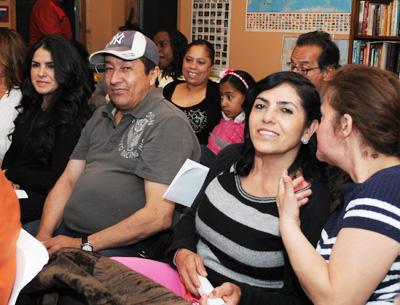Helping Teens by Helping Parents

“In school, Whalebone Village was always considered the ’hood. Everyone thought we didn’t really have anything and that it was a dangerous place because you could get beat up,” said Evelyn Collado, 23, who moved to the Whalebone Village Apartments in East Hampton when she was 4.
“Now, it’s different. It feels safer, and like more of a community.”
Still, in the local schools, Whalebone has a reputation for turning out troubled youth, said Virginia St. John, a social worker, who has been working with parents at the apartment complex. “The kids feel like they’re a target.”
Nestled in the woods off Middle Highway, the apartments provide one of the few low-income housing options on the South Fork.
Single mothers occupy 28 of the 46 units in the complex.
Gerry Mooney, who has managed the Whalebone Apartments since its founding in 1989, considers it an invisible world, or population of working poor that commonly falls outside the purview of many local residents.
“These are the waitresses, the landscapers, the nannies, the women cleaning your house,” said Mr. Mooney, a Bronx native who formerly worked as a community organizer. “These aren’t the folks you see walking down Main Street on the weekends. The only time you see them is when they’re walking behind the kids they’re taking care of.”
Combined with the recent suicides of three Latino high school students and December’s school shooting in Newtown, Conn., Mr. Mooney decided it was time to finally take action. “We’re not going to get rid of the guns. The guns are already here,” said Mr. Mooney. “These kids can either hurt themselves or they can hurt someone else.”
In January, Whalebone began offering therapeutic and preventative services for parents in the hopes of creating a more supportive and nurturing home environment that would ultimately benefit the youngest residents.
Of Whalebone’s more than 100 residents, including 40 children, Mr. Mooney focused his attention on the 18 teenage boys and girls, who, by virtue of their economic circumstance, are considered high-risk and likely to experience challenges related to impulsivity, substance abuse, and depression, among other issues.
On Wednesday evenings, Ms. St. John, who specializes in dialectical behavior therapy, leads a group of residents through various exercises to promote stress management, improve communication, and develop a more hopeful attitude. Dialectical behavior therapy, a derivative of cognitive behavior therapy, helps people learn different ways of thinking about and reacting to situations.
“These parents are there for each other,” said Ms. St. John. “They really are a village.” Though the weekly meetings are scheduled for an hour, they commonly stretch to two.
“One of the issues that has arisen is that these are first generation immigrants,” she said. “They’re raising children in a different culture than they were raised in.”
At a recent Wednesday night meeting, which focused on mindfulness as a way to reduce conflict in families, the more than 20 residents in attendance were all Latino. A few teenagers and younger children dotted the perimeter of the peach-colored room. Ms. St. John uses the help of a Spanish-speaking translator to conduct the sessions.
Ms. Collado, who was born in the Dominican Republic and graduated from East Hampton High School, has seen the population change considerably as the number of Latino residents has increased, with language barriers among first generation children and their parents a particular challenge. She lives in a one-bedroom apartment. Her parents live nearby in a two-bedroom unit. Of the 46 apartments, Latino residents occupy 32 units.
Ms. Collado now works as a tenant specialist at Whalebone, helping to deal with the various issues that arise for residents. She keeps a particular eye on the 13 teenage boys. For many of them, summertime spells boredom and a chronic lack of supervision.
This summer, with many of the parents working two and three jobs, children and teenagers will be the primary focus of the Wednesday night meetings. Though current funding will allow the program to “limp through until December,” its future hinges on raising of additional money. According to organizers, though they have raised $7,000 in recent weeks, $35,000 is still needed to continue the program next year.
“It’s a small number of high-risk individuals and sometimes it’s easier to get funding for something with a lot of kids and a generalized kind of approach,” Ms. St. John said.
“Being a single mother is an almost guaranteed path into poverty,” said Mr. Mooney, who sees many of the residents exhausted by their dual struggle to make ends meet while also trying to provide their children with a better life.
At Whalebone, the waitlist to qualify for an apartment now stretches 163 names long — with many individuals waiting five or more years.
Besides single mothers, the apartments are also occupied by a handful of senior citizens and disabled individuals whose yearly income averages $18,500. According to the United States Department of Health and Human Services, federal poverty guidelines for a family of three is $19,530. At Whalebone single households are capped at a $55,000 annual income. All residents allocate 30 percent of their income toward rent.
Challenges aside, slowly, a community is developing. For many residents, the hour-long sessions provide their only reprieve from weekly stresses.
Every Wednesday night, as she is packing up to go home, Ms. St. John is bombarded by the same question: Are you going to keep coming back?
